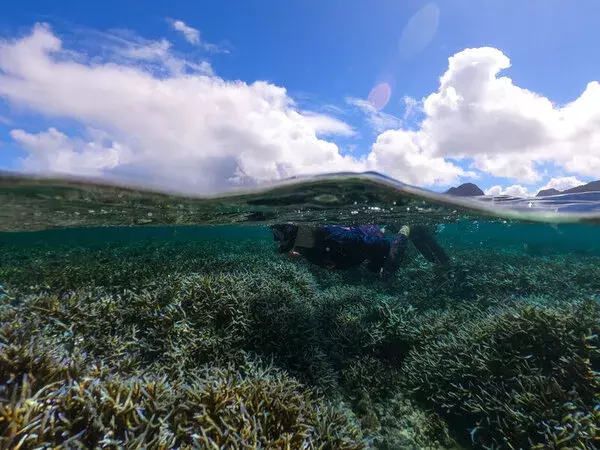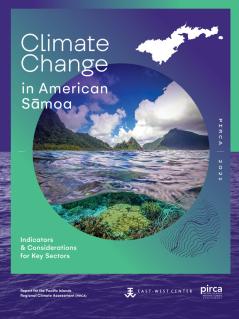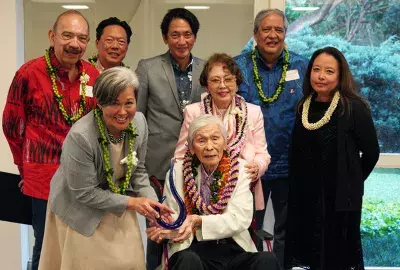Error message

OFFICE/DEPARTMENT
HONOLULU (June 8, 2021) – Human health risks, stronger cyclones, coral reef death, and coastal flooding are among the major challenges detailed in a new report on climate change in American Sāmoa. Threatened resources include high-value coastal infrastructure and the millions of dollars that ocean ecosystems add to American Sāmoa’s economy annually, according to the report by the Pacific Islands Regional Climate Assessment (PIRCA), a consortium of several government, NGO, and research entities.

Climate Change in the American Sāmoa: Indicators and Considerations for Key Sectors is one in a series of new PIRCA reports. Authors from American Sāmoa Community College, the University of Hawaiʻi, and the East-West Center—along with more than 20 technical contributors from local government, NGOs, and research—collaboratively developed the American Sāmoa PIRCA report.
"Places like American Sāmoa are always likely to be among the very first to see environmental impacts. The ocean is a major part of most aspects of Samoan life, and fishing is our chief industry,” said Congresswoman Uifa‘atali Amata, American Sāmoa's representative in Congress. “A thorough climate report that is specific to American Sāmoa will be an excellent lasting resource. I appreciate all the work that went into this process, as we work to safeguard our beautiful islands, especially issues like promoting reef health, preventing severe wave damage, and preserving shorelines from erosion.”
Key Messages
Climate Change in American Sāmoa lays out the changes the Territory is already experiencing, as well as what lies ahead. The key messages for decision-makers include:
- Temperatures have risen, and hotter days and nights affect human health. Heat waves can exacerbate a range of pre-existing health issues, and hot weather poses a particular threat to children and elderly people.
- Stronger tropical storms and cyclones are expected globally and around American Sāmoa. More intense tropical cyclones mean a greater potential for loss of life, damage, and public health issues from these storms.
- Sea level rise threatens infrastructure, including drinking water, agriculture, housing, and transportation, as well as ecosystems and cultural sites. More frequent and intense coastal flooding and erosion are anticipated as sea level rise accelerates. Continued effects of the 2009 earthquakes magnify local sea level rise in American Sāmoa.
- Oceans are warming, causing coral bleaching that is already widespread and severe. Extensive coral loss is possible within the next few decades if current trends in rising ocean temperatures continue. American Sāmoa has some of the oldest and largest corals in the world, and coral reefs inject millions of dollars annually into the local economy. In addition, American Sāmoa’s fringing coral reefs provide the best natural shoreline protection for the island.
About Climate Change in American Sāmoa and the PIRCA
The collective efforts of the technical contributors, coordinating authors, and PIRCA Advisory Committee made the American Sāmoa PIRCA report possible. The report builds upon the US Fourth National Climate Assessment, offering a closer look at climate change impacts in American Sāmoa and providing information for a wide range of sectors.
The PIRCA is funded and supported by the US National Oceanic and Atmospheric Administration’s RISA Program (through the Pacific RISA), the East-West Center’s Research Program, the Pacific Islands Climate Adaptation Science Center, and the US Global Change Research Program.
Contact American Sāmoa PIRCA authors:
Kelley Anderson Tagarino, University of Hawaiʻi Sea Grant College Program, American Sāmoa Community College, Mapusaga, +1-684-699-3353
Victoria Keener, East-West Center, Honolulu, HI, +1-808-944-7220
Zena Grecni, East-West Center, Honolulu, HI, +1-808-944-7242
Christopher Shuler, University of Hawaiʻi Water Resources Research Center, Honolulu, HI, +1-808-956-7847
Wendy Miles, US Fish and Wildlife Service and East-West Center, Honolulu, HI, +1-808-284-7636
Top Photo: Coral bleaching off Tāfuna, American Sāmoa. Credit: Valentine Vaeoso
HONOLULU (June 8, 2021) – Human health risks, stronger cyclones, coral reef death, and coastal flooding are among the major challenges detailed in a new report on climate change in American Sāmoa. Threatened resources include high-value coastal infrastructure and the millions of dollars that ocean ecosystems add to American Sāmoa’s economy annually, according to the report by the Pacific Islands Regional Climate Assessment (PIRCA), a consortium of several government, NGO, and research entities.

Climate Change in the American Sāmoa: Indicators and Considerations for Key Sectors is one in a series of new PIRCA reports. Authors from American Sāmoa Community College, the University of Hawaiʻi, and the East-West Center—along with more than 20 technical contributors from local government, NGOs, and research—collaboratively developed the American Sāmoa PIRCA report.
"Places like American Sāmoa are always likely to be among the very first to see environmental impacts. The ocean is a major part of most aspects of Samoan life, and fishing is our chief industry,” said Congresswoman Uifa‘atali Amata, American Sāmoa's representative in Congress. “A thorough climate report that is specific to American Sāmoa will be an excellent lasting resource. I appreciate all the work that went into this process, as we work to safeguard our beautiful islands, especially issues like promoting reef health, preventing severe wave damage, and preserving shorelines from erosion.”
Key Messages
Climate Change in American Sāmoa lays out the changes the Territory is already experiencing, as well as what lies ahead. The key messages for decision-makers include:
- Temperatures have risen, and hotter days and nights affect human health. Heat waves can exacerbate a range of pre-existing health issues, and hot weather poses a particular threat to children and elderly people.
- Stronger tropical storms and cyclones are expected globally and around American Sāmoa. More intense tropical cyclones mean a greater potential for loss of life, damage, and public health issues from these storms.
- Sea level rise threatens infrastructure, including drinking water, agriculture, housing, and transportation, as well as ecosystems and cultural sites. More frequent and intense coastal flooding and erosion are anticipated as sea level rise accelerates. Continued effects of the 2009 earthquakes magnify local sea level rise in American Sāmoa.
- Oceans are warming, causing coral bleaching that is already widespread and severe. Extensive coral loss is possible within the next few decades if current trends in rising ocean temperatures continue. American Sāmoa has some of the oldest and largest corals in the world, and coral reefs inject millions of dollars annually into the local economy. In addition, American Sāmoa’s fringing coral reefs provide the best natural shoreline protection for the island.
About Climate Change in American Sāmoa and the PIRCA
The collective efforts of the technical contributors, coordinating authors, and PIRCA Advisory Committee made the American Sāmoa PIRCA report possible. The report builds upon the US Fourth National Climate Assessment, offering a closer look at climate change impacts in American Sāmoa and providing information for a wide range of sectors.
The PIRCA is funded and supported by the US National Oceanic and Atmospheric Administration’s RISA Program (through the Pacific RISA), the East-West Center’s Research Program, the Pacific Islands Climate Adaptation Science Center, and the US Global Change Research Program.
Contact American Sāmoa PIRCA authors:
Kelley Anderson Tagarino, University of Hawaiʻi Sea Grant College Program, American Sāmoa Community College, Mapusaga, +1-684-699-3353
Victoria Keener, East-West Center, Honolulu, HI, +1-808-944-7220
Zena Grecni, East-West Center, Honolulu, HI, +1-808-944-7242
Christopher Shuler, University of Hawaiʻi Water Resources Research Center, Honolulu, HI, +1-808-956-7847
Wendy Miles, US Fish and Wildlife Service and East-West Center, Honolulu, HI, +1-808-284-7636
Top Photo: Coral bleaching off Tāfuna, American Sāmoa. Credit: Valentine Vaeoso







